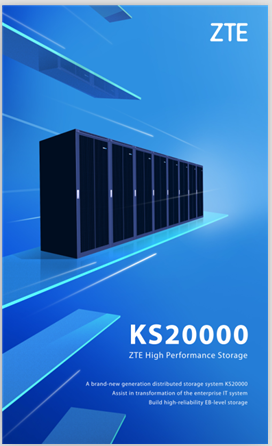Architecture Re-definition, New Storage Selection – ZTE Released a New Storage Product -- KS20000
Time:2022-06-30
At the just-concluded ZTE Cloud Networking Ecosystem Summit, ZTE released a new storage product with a new architecture: distributed disk array KS20000.
Disk array and distributed storage are two major product forms of enterprise storage. Disk array, which is an integrated scale-up architecture of software and hardware, is highly efficient. It has been the main form of enterprise storage for thirty years. Distributed storage, which is regarded as a software-defined storage system based on COTS hardware, is capable of mass scale-out. With the popularization of virtualized infrastructure, there are more applications of distributed storage.

On the other hand, these two product forms have their own architecture weaknesses. Disk array, which is developed for the traditional IT architecture, cannot meet the elastic scalability requirements of virtualized infrastructure. Different types of disk arrays are used for different applications. In addition, data migration between different devices is costly, and data silos are easily formed in DCs. In distributed storage, the data path in the architecture is long and the software efficiency is low. This low efficiency cannot obtain satisfactory performance even through high configuration of hardware. Therefore, distributed storage products can only be used in the scenarios of warm/cold data storage.
Based on an in-depth understanding of the storage architecture and years of technical accumulation in disk array and distributed storage, ZTE has launched a brand-new distributed disk array product: KS20000. It boasts both the advantages of a centralized storage system and a distributed storage system. It is the first distributed storage product in the industry that can completely replace HFAs (Hybrid Flash Arrays) and AFAs (All Flash Arrays). Under the same configuration, its performance is even or better. It is also the first scale-out disk array product in the industry that has mass scaling capability. It can achieve linear growth in performance and capacity.
The major architecture features of KS20000 are described as follows:
- Simple: The whole system consists of two hierarchies. Small-scale storage clusters are simple in networking and provide excellent performance. A KS20000 storage system is composed of multiple storage clusters connected by a management network.
- Efficient: In the service cluster, logically disk-sharing clusters are built through high-speed interconnection, simplifying resource management, and further improving performance through distributed global cache.
- Flexible: KS20000 data distribution employs a mapping table mechanism instead of a distributed hash (DHT) mechanism adopted by distributed storage products in the industry, thus supporting the flexible distribution and flow of fine-grained data within the system.
The main architecture features of KS20000 determine that KS20000 has unique advantages over other systems in terms of expansion capability, performance, and cost performance support.
KS20000 has the following advantages:
- High performance. Based on the efficient data processing architecture, the performance indexes of KS20000 can be even or better than those of the disk arrays with the same configuration, far exceeding the current major distributed storage products.
Its high performance feature is displayed as:
- KS20000 achieves high-performance EC: Compared with RAID5/6, it has higher performance. When the number of disks is the same, EC has higher performance than RAID1 or RAID10.
- Under the mixed flash configuration, KS2000 can easily exceed the customer's requirement for high-end disk array performance under the same configuration of OLTP model or OLAP model according to the performance grading standard for the group purchase test of mainstream operators.
- Under the full flash configuration, KS20000 can reach the high IO and low latency of the mainstream full-flash array products. This performance increases linearly with the number of nodes, fully meeting the requirements for building super-high performance storage pools.
- The mass expansion capability of KS20000 far exceeds that of traditional disk array products.
Compared with traditional disk array products, the scale-out architecture of KS20000 eliminates the bottleneck of the controller capability and better matches the virtualized infrastructure. KS20000 can support 2-4,096 controllers and provide up to EB-level data management capability. It is applicable to various application scenarios from small edge sites to large cloud DCs.
- KS20000 is a high performance cost product
- Based on the efficient cache and unique data mapping mechanism, KS20000 eliminates EC random write penalty completely, and its performance is excellent. Under the same configuration, its performance is 3-6 times that of mainstream open source products.
- While providing the same IO performance and ensuring the same data reliability, the capacity cost of KS20000 high-performance EC is reduced more than half of that of the copy mode.
- KS20000 supports data flow between different types of hard disks in the system, and dynamically matches data and storage media, thus achieving the overall high cost performance of the system.
As one of the few vendors in the storage field that have achieved self-development, ZTE has been investing in R&D of storage products for more than ten years, and has launched several generations of full series of disk array and distributed storage products. As the latest generation flagship storage product, KS20000 inherits ZTE's consistent features of high reliability, high performance and high quality. ZTE will continue to innovate, actively promote digital transformation, and work with partners for a win-win situation.

